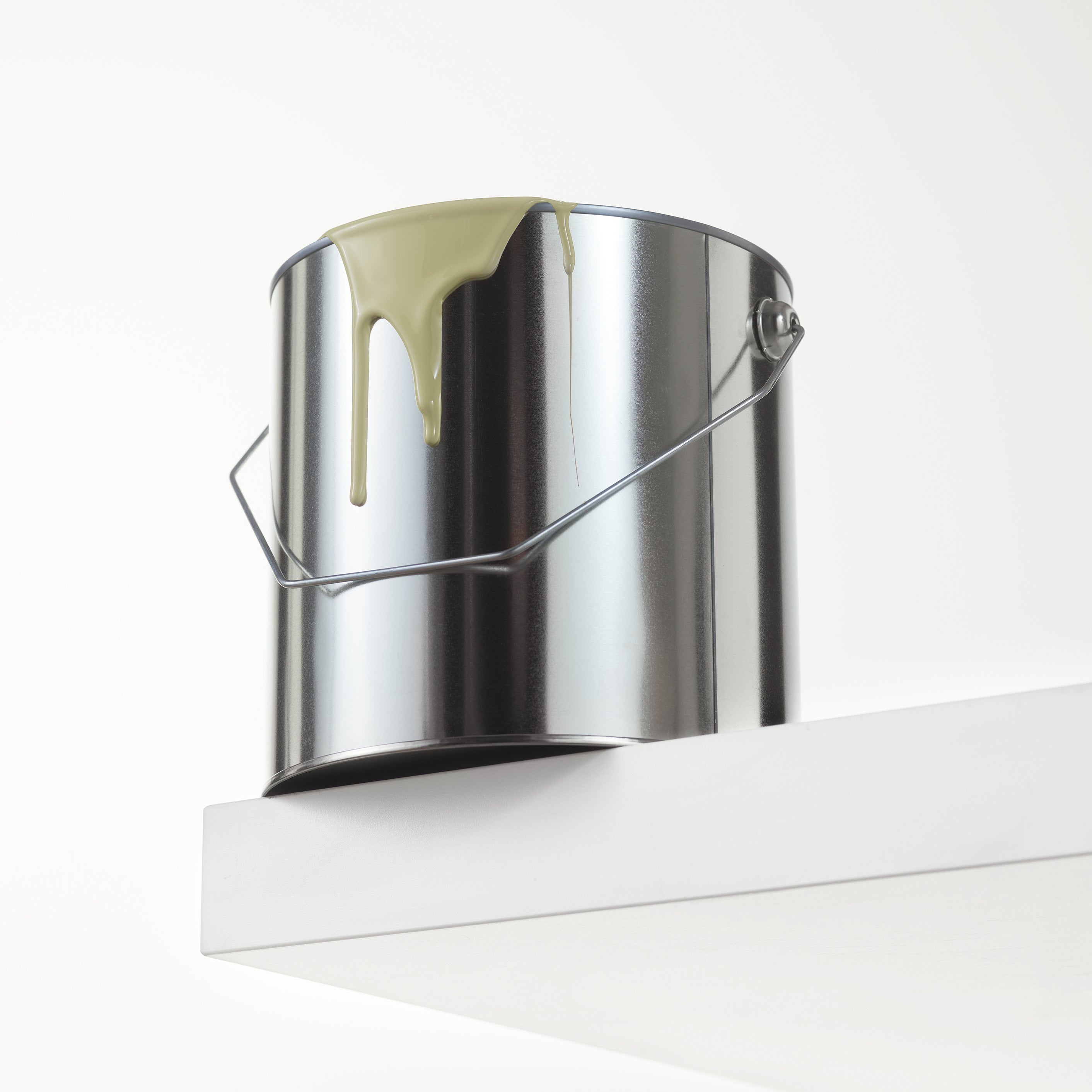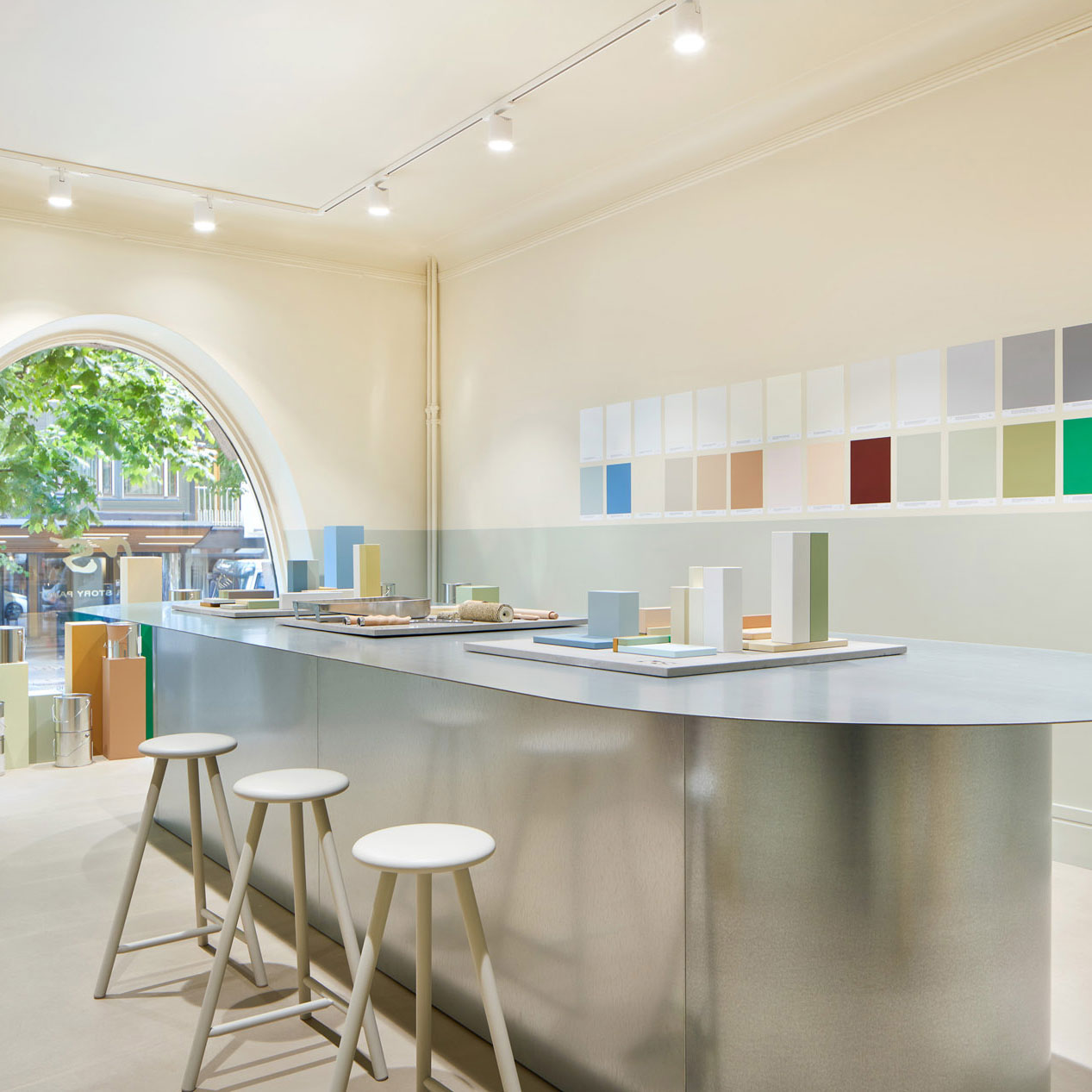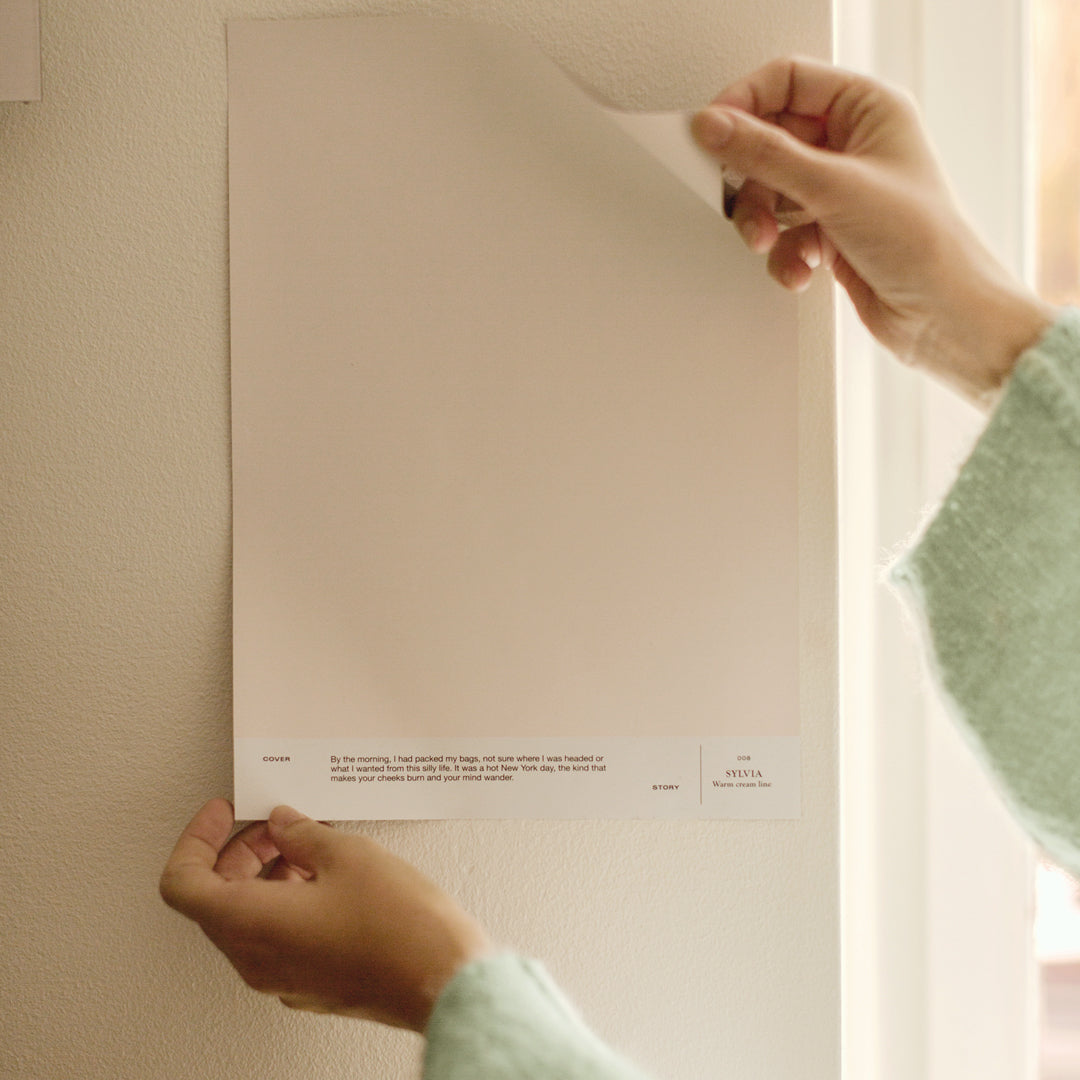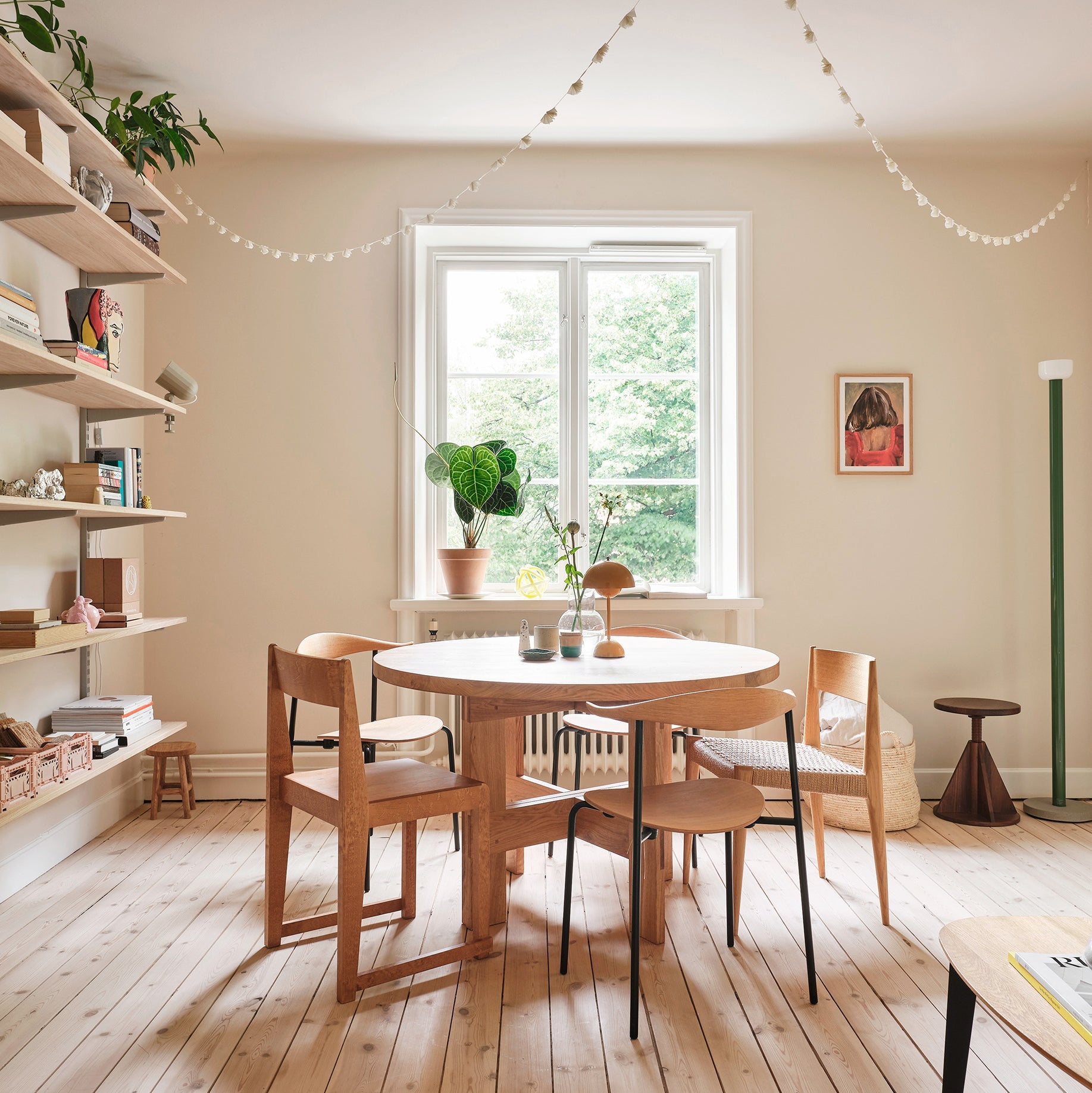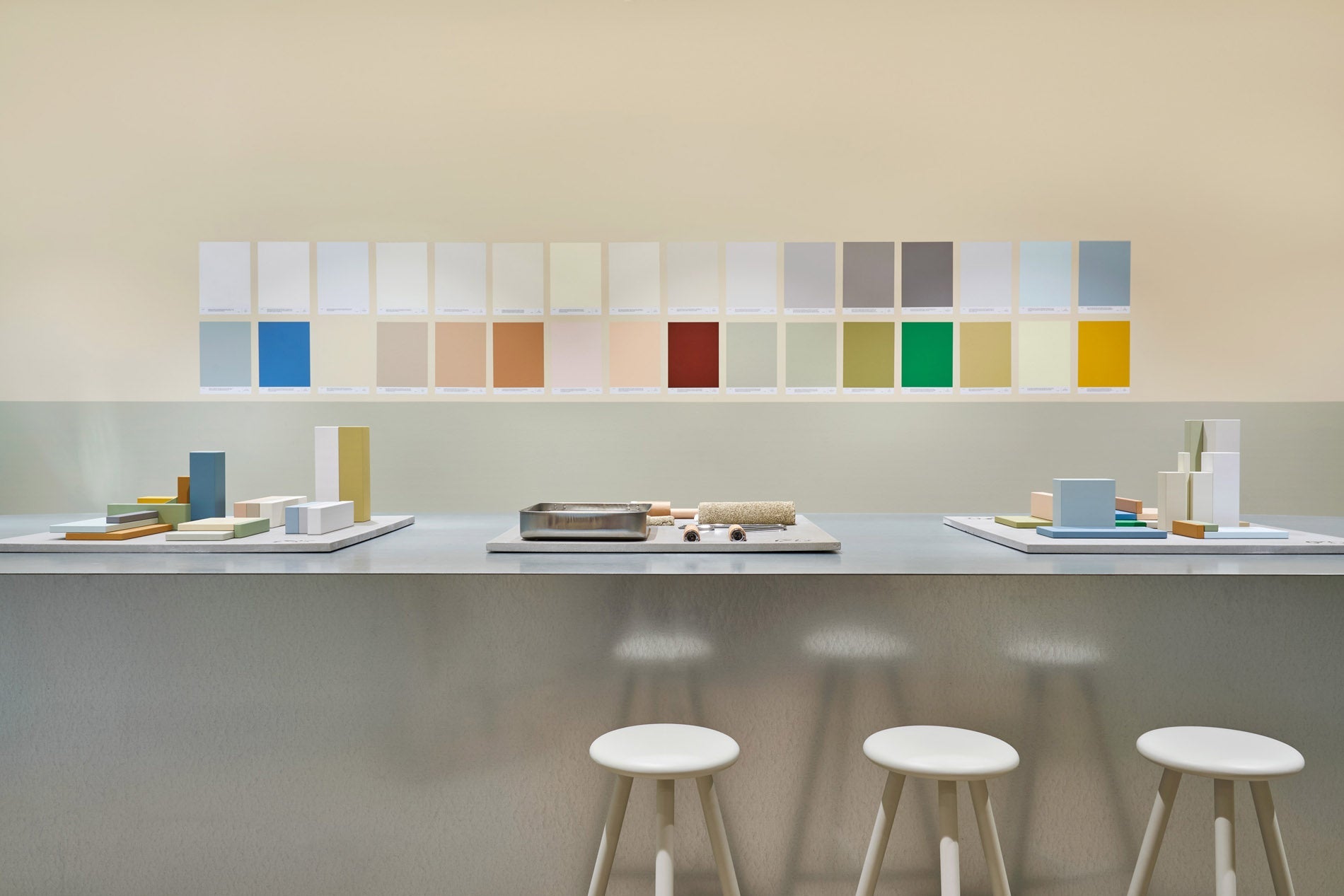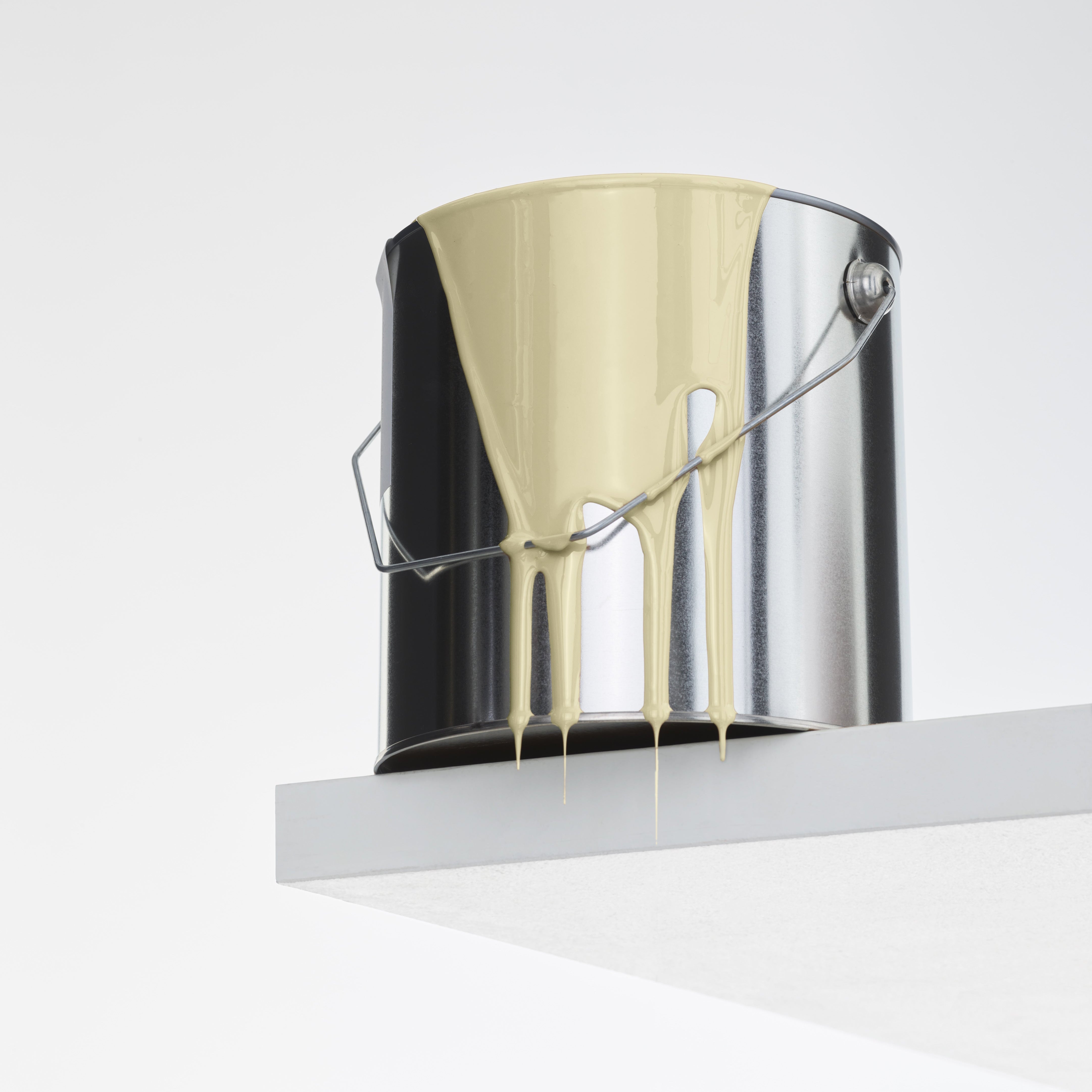Do you have questions?
Do you need help finding the right color, calculating the amount of paint required or choosing the best delivery method? We help you find the right colors for your home. Our color experts are happy to assist you with your questions, via chat, email or by phone.
Ordering and payment
How do I place an order?
Once you've found your favorite shade, click the ADD TO CART button. You can purchase a color sample by selecting "Sample (A4 adhesive)" under product selection or purchase a can (or cans) of paint by selecting that option. Select the desired quantity of samples or cans. When you click the shopping cart icon at the top right corner of the page you can see the products in your cart. You can also go to the shopping cart page to edit your order.
When you are satisfied with your choices, go to the checkout from the CHECKOUT button. Enter shipping and billing information and select a shipping and payment method. Payment is made via credit card or Klarna invoice.
Once the payment is successful, you will see an order summary and receive an order confirmation email. The products you buy will be packed for delivery as soon as possible, so now all you have to do is wait.
Can I add or remove products after I've submitted my order?
Unfortunately, we are unable to change orders after they've been submitted.
What payment methods do you accept?
We accept currently major credit cards, Apple pay and Paypal. Our payment system providers are Stripe and Paypal. We also accept Klarna payment options - credit cards and Klarna invoice.
I chose card payment as the payment method. When will the charge come through?
Payment will be debited from the card immediately upon a successful order.
How do I know my information is secure?
All customer information is treated confidentially and we ensure that all information you provide to us remains protected and private. We comply with data protection laws. Personal data can be used for the development of e-commerce operations and product range and for statistical purposes.
You can read more about the processing of personal data in our privacy statement. Additional questions can be emailed to info@coverstorypaint.com.
Delivery, exchange and return
What are the available delivery options and how much does it cost?
We deliver everything to your home door with free shipping.
How long does delivery take?
Shipping time varies between locations and is estimated at 6-10 business days for all orders. We deliver every order right to your home door with free delivery.
Can I track delivery?
You can track your order with the link provided in the shipping confirmation.
Can I change my shipping or billing address after placing my order?
Unfortunately, we are unable to change your order information once your order has been submitted.
What do I do if all the products I ordered did not arrive in the shipment?
If your order includes multiple paint cans and a set of painting supplies, your order may arrive in several different shipments. However, if not all products were received after reasonable time, please contact our customer service at info@coverstorypaint.com.
What do I do if a product I received is defective or incorrect?
Contact our customer service at info@coverstorypaint.com.
Please note that in plastic-free paint natural oil easily rises to the surface in the paint can. With thorough mixing the paint will regain its even consistency.
Do I have the right to exchange or return your products?
Our products have a 14-day return policy. Please contact us first by email at return@coverstorypaint.com and provide a brief reason for the return. In response, you will receive detailed instructions for returning the product.
The returned product must be unused, in a condition fit for sale and in its original packaging. The paint can must be unopened. You will have to pay the return postage. We will refund the purchase price of the product as soon as possible after the return is received, using the payment method used in the original payment. If you do not contact us within 14 days of receiving your order, we reserve the right not to accept returns. Please note that failure to pick up your order is not the same as a return.
How much does one paint can weigh?
One 3.6 liter can of paint with its packaging weighs about 6kg. A package of three paint cans and a painting supplies set weighs about 22kg.
Which countries do you ship to?
Currently www.coverstorypaint.com ships paint to Austria, Belgium, Czechia, Denmark, Estonia, France, Germany, Greece, Ireland, Italy, Latvia, Liechtenstein, Lithuania, Luxembourg, Monaco, Netherlands, Norway, Poland, Portugal, San Marino, Slovakia, Slovenia, Spain and Sweden.
Within Finland we ship from www.coverstorypaint.fi and within Netherlands also from www.coverstorypaint.nl.
General information about paints
What is a paint binder? And why do you use natural oil?
A paint binder binds the paint's ingredients together, enabling it to create a dry film on the surface you're painting. Most common paints use a variety of synthetic raw materials, such as plastic, as binders. Because we want our paint plastic-free, we use castor oil, a 100% renewable natural oil as our binder base.
The plastic-free binder does not form a plastic film on the painted surface but allows the structures to breathe.
What is VOC?
VOCs or Volatile Organic Compounds can leach into the indoor air from many sources such as furniture, textiles, cleaning products, and paint. They are harmful to human health and increase the ozone concentration in the atmosphere, which also hurts the environment.
Many hardware store paints release VOC emissions during painting and drying. We want our paint to be better for us and the planet, which is why Cover Story paint is completely VOC-free.
What does paint gloss mean?
Gloss refers to the ability of a surface to direct reflected light. Cover Story paints have excellent coverage and CS Signature matt finish. Low sheen level with approximately 5% light reflectance make them suitable for both walls and ceilings.
What does water-based paint mean?
Paints are often classified according to which thinner is used. You can come across water-thinned and solvent-thinned paints. The purpose of the thinner is to regulate the flowability, application properties, leveling and drying of the paint. Water is the most common thinner used in interior paints. Water-based paint is a safer choice than solvents for the environment, health and painting comfort. Yet, while water-based is a good thing, it doesn’t necessarily make the paint environmentally friendly or safe. Many water-based paints contain harmful VOCs as well as plastic. Because we want to make even better paints, all Cover Story paints are plastic-free and VOC-free. Because Cover Story paints evaporate mainly water into the air, the indoor air stays clean and the risk of allergens is low. Cover Story's near odorless and fast-drying water-based paints make the painting experience more comfortable.
Cover Story's paints
Why 51 shades instead of 510?
We believe that the color surrounding us is the most important interior element of a space. Yet choosing the perfect shade from hundreds of options is not easy. That’s why we’ve curated a color palette with just the right options. We promise each of our shades is just right – we've taken care of the guess work.
Does the paint need a primer?
Priming is usually only necessary for the first treatment of a surface. When painting on top of painted surfaces, no primer is needed with Cover Story paints. Our paints have excellent coverage and in most of the cases you will need only two coats of tinted paint to achieve the perfect smooth finish.
If you are painting a new wall or ceiling for the first time, painting an old, untreated surface, or if you are changing the color of the wall from very dark to very light, it is a good idea to put a primer under the topcoat. You can conveniently order Cover Story primer from our online store - look for 000 PRIMER.
Which surfaces is the paint suitable for?
With Cover Story interior wall and ceiling paints, you can paint unpainted and previously painted paneling, wood, plasterboard and stone surfaces indoors. The paints are also suitable for cardboard, brick and rendered surfaces. Thanks to their excellent breathability, Cover Story paints are also great for interior log surfaces.
Can I paint Cover Story directly onto an interior log surface?
You can. Because Cover Story paints are completely plastic-free, they do not form a plastic film on the paint surface, allowing underlying structures to breathe. Plastic paints impair the breathability of a log surface. That’s why Cover Story’s plastic-free paints are perfect for painting the log interior of your summer home.
Can Cover Story paints be painted directly onto a lacquered wood surface?
Cover Story paints are suitable for painting directly onto varnished wood. However, if you want to ensure adhesion, you can lightly sand the surface with sandpaper. A primer is not necessary.
Can I paint Cover Story paint over wallpaper?
Yes, you can paint Cover Story paint on top of wallpaper. Our paint works on surfaces in the same way as acrylate paints - it's opaque and spreads well. However, we generally recommend first removing the wallpaper for best results.
If you want to paint over the wallpaper, make sure the wallpaper is firmly adhered. Poorly adhered or broken wallpaper may warp during painting. Minor wear and tear may be ok, but painting over a surface will not repair it. Also, note that wallpaper seams and embossments are easily visible.
However, you can paint on top of paper wallpaper if it's in good condition. A few notes about painting: Apply the first coat of paint as quickly as possible, avoiding unnecessary rubbing, as paper wallpaper is very sensitive to moisture. Allow the first layer to dry well. You can paint the second layer thicker, as it will no longer be absorbed by the wallpaper but will sit on the first layer of paint.
Are Cover Story paints suitable for any dry interior at home?
Yes. With Cover Story paints, you can paint the walls and ceilings of all the dry spaces in your home.
You can also paint basements and cold porches, as well as spaces where the temperature varies throughout the year, as long as the surface doesn't get wet or soggy.
Can I use the same paint on the walls and ceiling?
Absolutely, Cover Story paints give surfaces a rich matt finish that is beautiful on interior walls and ceilings.
Please note, however, that you cannot paint directly onto a plaster ceiling surface with water-based paint. So before painting, make sure that your ceiling can withstand the water-based paint and will not soften on contact with water.
Can I paint Cover Story paint directly onto old (acrylate) paint?
Absolutely. Our paint behaves the same way on surfaces as hardware store paints that contain plastic, therefore you don't need to do a separate surface treatment when repainting.
Can I paint doors and moldings with the same Cover Story paint as the walls?
Cover Story paints are fully matt interior wall and ceiling paints that leave an even matt surface. Matt paints are more sensitive to changes than glossy paints if the surface is subjected to heavy wear. If you want a matt paint for doors, our paint works fine for repainting over traditional acrylic paints. If the doors don’t get heavy wear, you can paint them with Cover Story paint, but be prepared for possible repainting.
Unlike doors, moldings are less likely to endure wear and tear so they can be painted in the same shade as the wall without problems.
Can I paint directly onto fiberglass wallpaper?
Our paints can be used on fiberglass wallpaper. When calculating the amount of paint, it is worth noting that the wallpaper surface may absorb more paint than the smooth surface, so we recommend adding a little extra to the required amount of paint.
What temperatures can your paint withstand? Can I paint a fireplace with Cover Story paint?
Like regular interior wall paints, Cover Story paints have a heat resistance of about 80 degrees celsius. If the heat in the fireplace rises no higher than this, our paint is fine for this purpose.
Can your paint also be used to paint furniture?
Cover Story paints are fully matt interior wall and ceiling paints that leave an even matt surface. Matt finish is more susceptible to changes than glossy paints if the surface takes hard wear. That is why we recommend you use a different product for heavy-duty furniture.
However, in furniture and surfaces like shelving our paint may remain very well - but keep in mind that wear affects the durability of the paint surface and it's good to be prepared for patching.
Can I paint over a rough, decorative paint surface with Cover Story paint? Do I need a primer?
Cover Story paints work on paintable surfaces in the same way as ordinary acrylate paints, which means that you can also paint Cover Story paints over rough decorative surfaces like a plastered wall. Please note that the new coat of paint will not even out the decorative coating. However, the new paint will adheres and spread well, so you don’t need a coat of primer under the paint.
A rough surface may absorb more paint than a smooth wall surface, so we recommend applying a little more paint. Also, you should choose a roller with lengthier pile.
Can I paint on top of chalk paint with Cover Story paints?
If the chalk-painted surface has a layer of wax over it, the new paint will not stick and the wax should be removed before painting. If there is no wax on the paint, you can paint directly on top of the chalk paint.
Is your paint a safe choice for the nursery?
Absolutely. Our paints are odorless and plastic-free and do not release harmful VOC-emissions into the indoor air.
Unlike many hardware store paints that contain plastic binders, Cover Story paints use 100% natural oil as a binder. Because no plastic film forms on the surface to be painted, the structures are allowed to breathe, which reduces damage caused by moisture such as mold.
And because our color chart is curated in 47 lovely shades, your child is guaranteed to find their favorite!
Does the matt paint withstand cleaning?
All our paints are fully matt and leave a smooth matt surface. If the surface is subjected to dirty hands or splashes, the wall can be wiped with a damp cloth to prevent the dirt from sticking. The matt surface is resistant to gentle wiping, so it's fine to clean off the dirt and splashes caused by normal life.
You can also wash a matt wall with water. However, don't worry if the color darkens when it gets wet. A plastic-free paint surface will pass water and thus darken, but the color will even out as it dries. The paint will not come off when washed.
However, glossy paint copes better with hard wear and tear than matt paint.
Are all Cover Story paints plastic-free?
Yes. Most paints use a variety of plastic materials as binders. For us, plasticity is a fundamental choice. Why? Firstly, plastic-free paint does not form a film on the surface to be painted, but allows underlying structures to breathe. Secondly, environmentally harmful plastic does not biodegrade in nature. And third, there is already enough plastic in the world.
What are your paints' ingredients?
All paints basically consist of a binder, a pigment, a solvent and various excipients. All Cover Story paints are waterborne and made with the best pigments. The binder oil is renewable and plant based (castor oil).
Where do the raw materials come from?
Cover Story paint's raw material suppliers are located in Finland and Northern and Central Europe.
Are your paints vegan and produced without animal testing?
Yes. Cover Story paints do not contain products of animal origin and Cover Story does not test its paints on animals. Note, however, that all paints contain ingredients that may have been tested by chemical manufacturers in animal experiments over past decades. Animal testing of chemicals is regulated at the EU level by the REACH Regulation, and authorization for animal testing must be applied for from the European Chemicals Agency.
Does paint-tinting cost extra?
We don't charge extra for tinting. With Cover Story paints, the stated can price is the actual cost, unlike the pricing of traditional paint manufacturers. So you can make your decision based purely on what shade you like.
What size cans does the paint come in?
Cover Story paints are available in 3.6 liter can. One 3.6 liter can paints an area of about 30-40m² once.
Do I need a separate opener to open the paint can?
You don't need any special equipment to open the paint can. The lid can be opened with a screwdriver or even a house key.
What painting supplies do you sell?
We have put together three different sized painting supply kits containing everything you need. The EPISODE I set has a metal roller frame, a large and a small roller, brush, tape and mixing paddle. In addition to these, the EPISODE II set includes an extension arm and a roll of protective paper. The third set, ENCORE, contains top up supplies for those who have already painted. Find the right set for your needs in the painting supplies category.
How do you ensure the quality of paint batches?
For quality control, a laboratory sample is taken from each batch of paint. This ensures that the paints in each production round of Cover Story are odorless, easy to apply and quick-drying. Quality control ensures that all Cover Story paint shades are the CS signature matt finish we have developed.
Use, recycling and maintenance
Why do you use adhesive sample pieces instead of standard sample swatches?
It's difficult to choose the perfect shade of interior paint based on tiny printed color strips. That’s why we use A4 adhesive samples that stick directly to the wall or ceiling and are painted with genuine Cover Story paints.
Why should I do my own paint job?
Because we've made it so easy! In addition to being financially a good option, a DIY paint job is also fun and rewarding. We think painting is decorating, not renovating. With the right supplies (found in the Cover Story supplies set), high-quality paints, and a few tips (check out the footer for work instructions) you’re sure to succeed. We believe that painting with a friend and a good playlist is not only therapeutic, it's the best way to put your own unique stamp on your home.
When shouldn't I do my own paint job?
Sometimes life gets in the way. If you simply don't have the time or energy, the fastest way to surround yourself with your favorite shade is to use a professional painter. In large-scale refurbishment projects or when decorating a new build, sometimes it can make sense to invest in the expertise of a professional.
How much paint do I need?
The amount of paint required for one coat can be estimated by multiplying the width of the surface to be painted by its height. Be sure to then double this number, as you will get the best result with two coats of paint.
One 3.6 liter paint can is enough for one coat on a surface of 30-40m².
If you have leftover paint, give it to a friend or store the can carefully for the next use. See the tip below on storing an opened paint can.
How long does the paint last?
An unopened paint can can be stored without deterioration for several years. After it's been opened, it can be kept in a warm, dry place with the lid tightly closed. Water-based paints do not withstand freezing, so don't leave your paint in the shed over winter.
Tip: If you think you may not use all the paint at once, don't dip your painting equipment in the can as you paint. Instead, pour the paint into a separate container, such as a roller tray - this way you won’t transfer contaminants to the can and the paint will stay usable for longer. Clean the can's edges and lid and close it tightly for the next use. Be sure to mix the paint thoroughly before the next paint job.
A strange color has appeared on top of the paint. Is the paint ruined?
Don't worry if oil has formed on the surface of the paint. In plastic-free paints natural oil will commonly rise to the top of the tin. With vigorous mixing or shaking, the oil will blend back in with the pigments.
What do I do if the paint has frozen?
Unfortunately, water-based paints do not withstand freezing and unusable paint should be recycled. Take a look at the following recycling instructions.
How can I recycle surplus paint and painting supplies?
If there is a lot of paint left over, delight your friend with a batch of Cover Story! Alternatively, an opened paint can can be stored for future use (see previous FAQs).
Once you have painted all the surfaces you want, recycling is the last stage of the painting project. Paint recycling varies from country to country, so find out local recycling practices before you put paint in the bin. Wet paint is often classified as chemical waste (despite the fact that our paint is plastic-free), which has its own separate collection points.
If the paint has caked to the bottom of the can you can dispose of it into mixed waste. Metal can goes into metal waste.
Painting supplies should be cleaned immediately after use and stored for the next painting project. The high quality painting tools in the Cover Story painting supply kits have been selected and tested so they'll last time after time when well maintained. Dry brushes and rollers that are past their usefulness belong to mixed waste, as does the wooden mixing stick. The metal roller frame and any empty paint cans should go to metal collection.
How should paint cans be recycled?
Cover Story paints come in cans that can be recycled as part of your metal collection. Recycling metal saves energy and natural resources, as metals can be recycled numerous times without deteriorating in quality. However, check that there is no liquid or scaly paint on the bottom of the can - if there is, then the can is chemical waste. If there are traces of completely dried paint left on the bottom, the can is recyclable.
How should I clean my equipment?
It's recommended you clean painting supplies immediately after use, as the paint will stick to the brushes as it dries. Cover Story paints are water soluble, which means that water alone is enough to clean the equipment. However, brushes must be soaked and any paint residue removed from equipment before you can rinse it under running water.
First blot or wipe off excess paint on the edge of the paint can or onto some newspaper, then put the brushes in a separate container such as a bucket. Allow the paint residue to settle to the bottom of the soaking pan. Water separated from the precipitate can be poured down the drain and equipment can be given a final rinse under running water.
Dried paint can be disposed of in mixed waste. If you are planning to paint the next day, put the tools in a plastic bag. This way you avoid unnecessary washing and you can easily continue your paint job.
How should I clean a painted surface?
Surfaces painted with Cover Story paints can be washed with water and, if necessary, with a neutral detergent. Ceilings and walls are best cleaned with a dampened mop or microfiber cloth.
Sustainability
Where are the paints made?
We produce all of our paint in Southern Finland. This means less transport is required, and therefore less carbon emissions are generated. In addition we have more surveillance and control of the production process.
Where are the painting supplies made?
Painting supplies are made in Italy, the Czech Republic and China.
Where and from what materials are painting supplies and packaging packages made?
Cover Story packaging for paints and supplies is manufactured in Europe. The wooden materials for the roller arms and extension arm are Danish beech, the paint cans are made of European-sourced tin-coated steel, and our paint trays are metal. Plastic and metal components are from China.
What is done with the paint waste that's generated during manufacturing?
No paint waste is generated during manufacture - any product residue is utilized in the next production batch.
Contact Us
Do you have any other questions?
Our customer support is available Monday to Friday: 9am-6pm. Average answer time: 24h.


